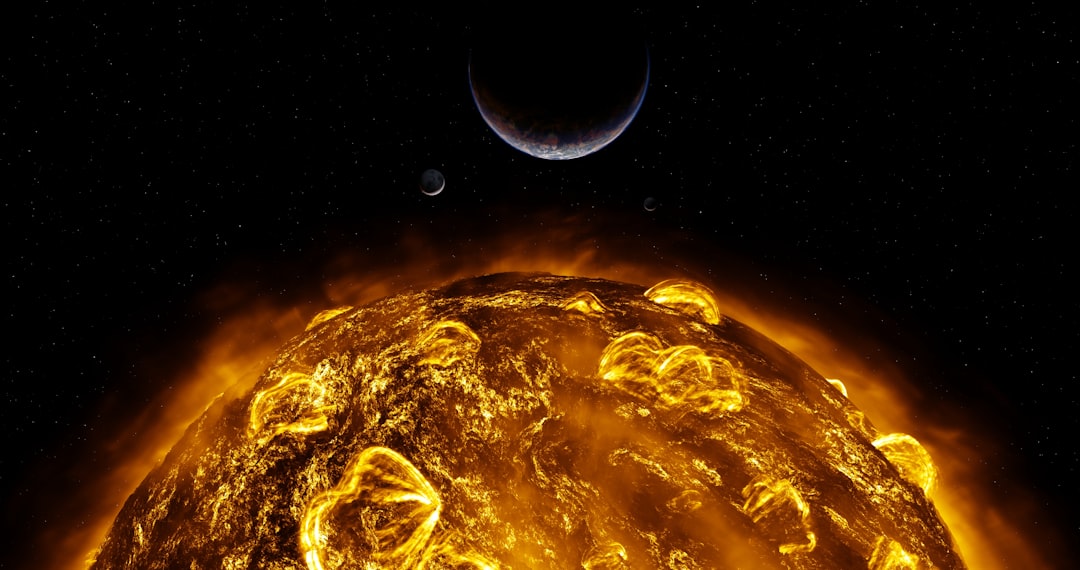The Earth, a dynamic and complex planet, harbors a wealth of scientific mysteries beneath its surface. While the outer layers are accessible to human exploration, the deeper regions remain largely enigmatic. Scientists have long been fascinated by the deep Earth, as it holds crucial information about the planet’s formation, evolution, and ongoing processes.
The study of these hidden realms not only enhances understanding of geological phenomena but also sheds light on the intricate systems that govern life on the surface. As researchers delve deeper into the Earth’s interior, they uncover secrets that challenge existing theories and inspire new lines of inquiry. The quest to understand the deep Earth is driven by a combination of curiosity and necessity.
By investigating these layers, scientists aim to unravel the complexities of geological processes such as plate tectonics, volcanic activity, and earthquake generation. Each discovery adds a piece to the puzzle of how the Earth functions as a whole, revealing the interconnectedness of its various systems.
As technology advances, the potential for groundbreaking discoveries in deep Earth research continues to expand, promising to illuminate the mysteries that lie beneath.
Key Takeaways
- The deep Earth holds many scientific mysteries that are still being explored and understood.
- The composition and structure of the Earth’s mantle play a crucial role in shaping the planet’s surface and processes.
- Understanding the Earth’s magnetic field is key to investigating the core and its impact on the planet.
- Deep Earth processes have a significant influence on plate tectonics and the movement of the Earth’s crust.
- Uncovering the secrets of the Earth’s inner core is essential for gaining a deeper understanding of the planet’s dynamics and evolution.
The Composition and Structure of the Earth’s Mantle
The Earth’s mantle, situated between the crust and the core, constitutes a significant portion of the planet’s volume. Composed primarily of silicate minerals rich in iron and magnesium, the mantle exhibits a complex structure characterized by varying compositions and physical states. The upper mantle is relatively rigid, while the lower mantle becomes increasingly ductile due to the immense pressure and temperature conditions found at greater depths.
This stratification plays a crucial role in the dynamics of mantle convection, which drives plate tectonics and influences surface geology. Understanding the composition of the mantle is essential for deciphering its behavior and interactions with other layers of the Earth. Seismic studies have provided valuable insights into the mantle’s structure, revealing features such as subduction zones and mantle plumes.
These geological formations are critical for understanding how heat is transferred from the Earth’s interior to its surface, ultimately affecting volcanic activity and mountain formation. As researchers continue to analyze mantle samples and seismic data, they are piecing together a more comprehensive picture of this vital layer, enhancing knowledge of its role in Earth’s geological processes.
Investigating the Core: Understanding Earth’s Magnetic Field

The Earth’s core, composed primarily of iron and nickel, is a region of extreme temperatures and pressures. It is divided into two parts: a solid inner core and a liquid outer core. The movement of molten iron in the outer core generates the Earth’s magnetic field through a process known as the geodynamo.
This magnetic field is not only essential for life on Earth but also serves as a protective shield against harmful solar radiation. Understanding the dynamics of the core is crucial for comprehending how this magnetic field is generated and maintained. Recent advancements in geophysical techniques have allowed scientists to probe deeper into the core’s properties and behavior.
By analyzing seismic waves generated by earthquakes, researchers can infer information about the core’s composition and state. Additionally, laboratory experiments simulating core conditions have provided insights into how materials behave under extreme pressures and temperatures. These investigations are vital for understanding not only the Earth’s magnetic field but also its historical changes and potential future shifts, which could have significant implications for technology and life on Earth.
The Role of Deep Earth Processes in Plate Tectonics
| Deep Earth Process | Impact on Plate Tectonics |
|---|---|
| Mantle Convection | Drives the movement of tectonic plates |
| Subduction | Leads to the formation of deep ocean trenches and volcanic arcs |
| Ridge Push | Pushes tectonic plates away from mid-ocean ridges |
| Slab Pull | Pulls tectonic plates into the mantle at subduction zones |
| Plumes | Creates hotspots and volcanic activity on the Earth’s surface |
Plate tectonics is a fundamental concept in geology that explains the movement of large plates on the Earth’s surface. Deep Earth processes play a critical role in driving this movement, as they are responsible for generating heat and creating forces that influence plate dynamics. The convection currents within the mantle, driven by heat from the core, create a complex system of interactions that lead to the movement of tectonic plates.
This movement can result in various geological phenomena, including earthquakes, volcanic eruptions, and mountain building. The interaction between tectonic plates is often marked by boundaries where they converge, diverge, or slide past one another. These boundaries are sites of intense geological activity, influenced by deep Earth processes such as subduction and rifting.
For instance, when one plate is forced beneath another in a subduction zone, it can lead to significant geological events like earthquakes and volcanic eruptions. Understanding these processes is essential for predicting geological hazards and mitigating their impacts on human populations.
Uncovering the Secrets of Earth’s Inner Core
The inner core of the Earth remains one of its most mysterious regions. Despite being located approximately 3,000 kilometers beneath the surface, scientists have made significant strides in understanding its properties and behavior. Composed primarily of solid iron, the inner core is subjected to extreme temperatures exceeding 5,000 degrees Celsius.
This intense heat causes unique physical phenomena that influence not only the core itself but also the entire planet. Recent studies suggest that the inner core may be growing over time as it cools and solidifies from the outer core’s molten state. This growth has implications for understanding Earth’s thermal history and its magnetic field’s stability.
Additionally, researchers have discovered that seismic waves travel through the inner core at varying speeds depending on their direction, indicating complex structures within this solid mass. These findings challenge previous assumptions about the inner core’s uniformity and open new avenues for research into its formation and evolution.
Exploring the Connection Between Deep Earth and Volcanic Activity

Volcanic activity is one of the most visible manifestations of deep Earth processes at work. The movement of magma from deep within the mantle to the surface is driven by various factors, including pressure changes and temperature variations. Understanding these processes is crucial for predicting volcanic eruptions and assessing their potential impacts on surrounding communities.
Deep Earth processes contribute to volcanic activity through mechanisms such as mantle plumes and subduction zones. Mantle plumes are columns of hot material that rise from deep within the mantle, leading to volcanic hotspots like those found in Hawaii. Conversely, subduction zones can create conditions conducive to melting rock and generating magma as one tectonic plate descends beneath another.
By studying these interactions, scientists can gain insights into volcanic behavior and improve eruption forecasting models.
The Impact of Deep Earth Processes on Earthquakes
Earthquakes are another significant consequence of deep Earth processes, resulting from the release of energy along fault lines where tectonic plates interact. The movement of these plates is influenced by forces generated deep within the Earth, including mantle convection and stress accumulation along faults. Understanding these processes is essential for assessing earthquake risks and developing effective mitigation strategies.
Seismology plays a crucial role in studying earthquakes by analyzing seismic waves generated during tectonic activity. By examining these waves’ patterns and characteristics, scientists can infer information about fault lines’ behavior and predict potential seismic events. Additionally, research into deep Earth processes helps identify regions at higher risk for earthquakes based on their geological history and tectonic settings.
Examining the Role of Deep Earth in the Carbon Cycle
The deep Earth also plays a vital role in regulating the carbon cycle, which is essential for maintaining life on our planet. Carbon is stored in various forms within Earth’s interior, including in minerals found in the mantle and crust. Deep Earth processes contribute to carbon cycling through mechanisms such as subduction, where carbon-rich sediments are transported into the mantle.
As carbon is subjected to high pressures and temperatures within the mantle, it can undergo transformations that influence its availability at the surface. For instance, volcanic eruptions can release carbon dioxide back into the atmosphere, impacting climate change and global temperatures. Understanding these deep Earth processes is crucial for comprehending how carbon moves through different reservoirs on Earth and how human activities may disrupt this delicate balance.
The Influence of Deep Earth on Climate and Weather Patterns
The interplay between deep Earth processes and surface climate is complex yet significant. While atmospheric phenomena often dominate discussions about climate change, deep Earth dynamics also contribute to long-term climate patterns through mechanisms such as volcanic eruptions and tectonic shifts. For example, large-scale volcanic eruptions can inject significant amounts of ash and gases into the atmosphere, leading to temporary cooling effects on global temperatures.
Additionally, tectonic movements can alter ocean currents and land formations over geological time scales, influencing climate patterns across continents. The uplift of mountain ranges can affect regional weather systems by altering wind patterns and precipitation distribution.
Unraveling the Mysteries of Deep Earth’s Geological Time Scale
The geological time scale provides a framework for understanding Earth’s history through its various epochs marked by significant events such as mass extinctions or major geological shifts. Deep Earth processes have played a crucial role in shaping this timeline by influencing continental drift, mountain formation, and volcanic activity throughout history. By studying rock formations and fossil records alongside deep Earth dynamics, scientists can piece together a more comprehensive narrative of Earth’s evolution over billions of years.
This interdisciplinary approach allows researchers to connect surface phenomena with underlying geological processes that have shaped life on our planet. As new discoveries emerge from deep Earth research, they continue to refine our understanding of this intricate timeline.
The Future of Deep Earth Research: New Technologies and Discoveries
As technology advances rapidly, so too does the potential for groundbreaking discoveries in deep Earth research. Innovations such as high-performance computing simulations allow scientists to model complex geological processes with unprecedented accuracy. Additionally, advancements in seismic imaging techniques enable researchers to visualize subsurface structures more clearly than ever before.
These technological developments promise to enhance understanding of deep Earth dynamics significantly while addressing pressing questions about planetary evolution and sustainability. As researchers continue to explore this uncharted territory beneath our feet, they remain committed to unraveling its mysteries—ultimately contributing to a more profound understanding of our planet’s past, present, and future. In conclusion, deep Earth’s scientific mysteries encompass a vast array of topics that are critical for understanding not only geological processes but also their implications for life on our planet.
From investigating its composition to exploring its influence on climate patterns and natural disasters, each aspect reveals interconnected systems that shape Earth’s environment over time. As research continues to evolve with new technologies and methodologies at hand, humanity stands poised to unlock even more secrets hidden within this enigmatic realm beneath our feet.
Deep Earth scientific mysteries continue to intrigue researchers as they delve into the enigmatic processes occurring beneath our planet’s surface. One fascinating aspect of this field is the study of seismic waves and their ability to reveal hidden structures within the Earth’s mantle and core. For those interested in exploring more about the mysteries of our planet, an article on Hey Did You Know This provides insights into the latest discoveries and theories in geoscience. This resource offers a glimpse into the complex and often surprising phenomena that shape our understanding of Earth’s inner workings.
FAQs
What are some of the scientific mysteries of the deep earth?
Some of the scientific mysteries of the deep earth include the nature and behavior of the Earth’s inner core, the processes driving plate tectonics, the origin and composition of deep-sea trenches, and the dynamics of mantle convection.
Why is the Earth’s inner core a scientific mystery?
The Earth’s inner core is a scientific mystery because it is difficult to study directly. Its extreme pressure and temperature conditions make it challenging to conduct experiments or gather direct observations. As a result, scientists rely on indirect methods such as seismic waves to infer its properties.
What drives plate tectonics and why is it a mystery?
Plate tectonics is driven by the movement of the Earth’s lithosphere, but the exact mechanisms behind this movement are not fully understood. The forces driving plate tectonics are still a subject of ongoing research and debate among geoscientists.
What are deep-sea trenches and why are they a scientific mystery?
Deep-sea trenches are long, narrow depressions in the ocean floor that are associated with subduction zones. The origin and composition of these trenches are not fully understood, and their formation is a subject of ongoing scientific investigation.
What is mantle convection and why is it a scientific mystery?
Mantle convection refers to the movement of the Earth’s mantle driven by heat from the core. The exact dynamics of mantle convection, including the patterns and processes involved, are still not fully understood, making it a scientific mystery.
